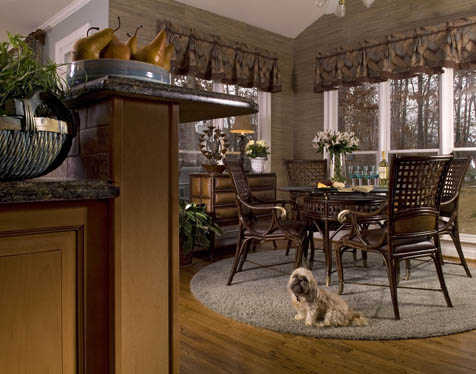Designing Your Home With Pet-Friendly Decor
Animal Accents

Let’s face it: Our pets are members of the family, no longer relegated to a backyard doghouse. Decorating with your pet dog or cat in mind is really just one part of what we call lifestyle design. Simply put, it’s relatively easy to make a room look like it’s been pulled from the pages of a magazine if no one has to live there. It’s an entirely different undertaking to make it look and feel great, while also accommodating the demands of your lifestyle, including children and pets. So, if Fido or Fluffy are part of your family portrait, here are a few tips to keep in mind as you select your home’s furnishings.
When it comes to floor coverings, your dog’s toenails are the thing to think about. Big dogs can destroy the finish on even the finest hardwood floor, particularly right in front of that beautiful French door that looks out over your squirrel-inhabited backyard. Rather than hardwood, think about a wood laminate or ceramic tile in areas where you want hard-surface flooring. Older dogs may need traction, particularly on stairs, so an area rug in the living room or runner on the stairs can make life less scary for your critter.
In carpeted areas, your best bet is a high-quality cut pile, again to deter the effects of those toenails. Looped pile carpets, such as berbers, can easily snag, and if Fido gets a yarn caught on his nail you may see huge damage in no time flat (picture that sweater with a loose yarn unraveling as it’s pulled).
Where your upholstered furniture pieces are concerned, consider coverings that will stand up to having your pets rub against or even lounge on them. If your animal sheds (and it’s the rare pet that doesn’t), opt for upholstery fabrics that can easily be cleaned. Leather is one good example of this; however, it should definitely be avoided if Fluffy has claws. Other good choices include a durable, low-nap cotton (chintz works great), cotton polyester, or microfiber. You can also choose an upholstery fabric that blends with your pet’s fur.
If you have a puppy in the house, try to avoid exposed wooden legs on furniture, as these may look to him like his own personal teething ring. Cats may also find exposed wood a satisfying scratching post, so consider metal coffee and end tables.
A true test of a good designer is one who can dress your windows for privacy, light control, and beauty while still making them pet friendly. Our four-legged loved ones live to bask in the sunlight and look out the windows, so rather than frustrate yourself and them, opt for window treatments that will serve both your needs and theirs. Think hard before choosing silk draperies that puddle lavishly on the floor, and look more toward options like shades, which can be pulled completely out of the way, paired with tailored side panels and an awesome top treatment.
If you are gone much of the day and Fido is on his own, think about choosing one window whose coverings can be left open, perhaps on the back side of your home, to accommodate your pet’s sun basking and scenery watching. There’s nothing like a mailman on one side of a window, a frenzied dog on the other, and a partially opened window treatment between them to set you up for an unpleasant end to your day.
Finally, rather than focusing only on the “don’ts” of decorating with pets, think about some special ways that you can actually “do” for them. It’s okay to splurge on a designer doggie bed or chic food-and-water dishes that complement your decorating scheme. Perhaps it could be your pet’s reward for getting good grades in obedience school.



